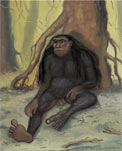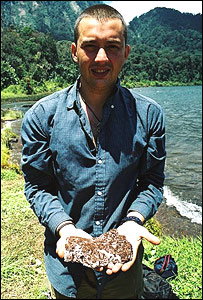New Davies-Orang Pendek Expedition
Posted by: Loren Coleman on September 8th, 2011

Adam Davies, cryptozoologist and author of Extreme Expedition: Travel Adventures Stalking the World’s Mystery Animals, is doing it again. He is off to the bush. In search of Orang Pendek. He probably is getting on a plane as you read this.
He writes:
“We leave Friday, September 9, 2011 and will return on the 25th of September, late night. I will be leading the expedition, which is entitled The CFZ Sumatra Expedition 2011. There will be two teams to maximise our chances of finding evidence of the creature.”
Expedition members are heading to the Indonesian island of Sumatra this week on the trail of one of the most elusive and fascinating creatures in hominology, anthropology, zoology, and cryptozoology: Orang Pendek, the walking ape.
For more than a century, there have been convincing reports of the creature’s existence. Yet no-one has ever managed to find categorical proof that the island is home to a species of ape that walks freely on its back legs.

Adam Davies’ recent journal article on Orang Pendek outlined the growing body of evidence for this new ape.

Explorer Adam Davies is leading this expedition to see if more evidence of these potentially new apes can be found. (Media and blogs are reporting that the quest’s leader is Richard Freeman; such accounts are incorrect. This appears to be based on the fact that Freeman gave an interview about the search to The Guardian.)
As Davies has written, there seems to be a genuine scientific basis for the consideration that an unknown anthropoid that walks bipedally might exist in Indonesia.
About Loren Coleman
Loren Coleman is one of the world’s leading cryptozoologists, some say “the” leading living cryptozoologist. Certainly, he is acknowledged as the current living American researcher and writer who has most popularized cryptozoology in the late 20th and early 21st centuries.
Starting his fieldwork and investigations in 1960, after traveling and trekking extensively in pursuit of cryptozoological mysteries, Coleman began writing to share his experiences in 1969. An honorary member of Ivan T. Sanderson’s Society for the Investigation of the Unexplained in the 1970s, Coleman has been bestowed with similar honorary memberships of the North Idaho College Cryptozoology Club in 1983, and in subsequent years, that of the British Columbia Scientific Cryptozoology Club, CryptoSafari International, and other international organizations. He was also a Life Member and Benefactor of the International Society of Cryptozoology (now-defunct).
Loren Coleman’s daily blog, as a member of the Cryptomundo Team, served as an ongoing avenue of communication for the ever-growing body of cryptozoo news from 2005 through 2013. He returned as an infrequent contributor beginning Halloween week of 2015.
Coleman is the founder in 2003, and current director of the International Cryptozoology Museum in Portland, Maine.










Fourth time round for the CFZ and I am really hopeful. We are taking precautions when we gather the hair etc samples that should eliminate any possibility of human DNA contamination. Also far more trail cameras than we have ever had before, and enough people to deploy two parties.
@ greatanarch
what is the battery life for trail cameras? I’m curious if a solar power solution could be accomplished for this technology?
Good luck to Adam, lets hope all his experience will bring success. If hiring local help ,fingers crossed they be made of sterner stuff than the last local breaking down at the first sign of a monkey
Greatanarch:
Hello 🙂
You are a part of this expedition? If so, are you planning on getting a type specimen (capture or kill)?
i find it very interesting why scientists are so much more willing to except this animal than bigfoot. If these exist than obviously other such species are definetly possible and more likely probable. I know that they would probably say because Sumatra is so much more remote that it could hide such an animal, but if your talking an animal that is very intelligent, beyond problem solving, then they could easily remain unnoticed in a rural area, let alone vast country. Id be willing to wager that in British Columbia and some parts of the US, it is just as hard to get through, and just as remote than any part of Sumatra. Terrain and obstacles may vary along with weather, but when push comes to shove, if this animal is proved, than i dont see what the problem would be in investigating the bigfoot phenomenon on a more scientific scale. I mean I when it comes to believability on upright hairy men walking the wilds, i think Native American tales have just as much validity as Sumatran native tales. So why do scientists give this animal more credibility and more attention. Obviously neither population segment is lying on what theyve seen. They both exist. So Frustrating!
trapper9990:
Here’s what I think is going on with the relative situations of the sasquatch and orang pendek (and what the heck, the yeti too).
1. Apes Aren’t Found In The Temperate Zone. We still have scientists trying to pin the tropical ape template on the sasquatch to ‘prove’ that it doesn’t exist. Never mind that it’s hard to find a kind of animal – deer; cats; dogs; monkeys (primate!); bears; cetaceans; pinnipeds; frogs/turtles/lizards, I could go on and on – that doesn’t have representatives in both the tropics and the temperate zone (and many if not most you can extend to the polar regions as well). The yeti at least lives in a ‘more plausible’ place (Asia, although temperate zone and almost polar cold in winter at elevations frequented by yeti); and sightings of the animal by credible European observers have, if not a longer continuous history, one that’s been more publicized. The shroud of mystery hanging over the yeti’s habitat even into the present day sure hasn’t hurt.
2. North America Is All Paved Over, Populated and Under Constant Surveillance. No. Sumatra is, if anything, LESS hospitable to a large secretive primate. As you point out, large swatches of the continent don’t see but a few visitors per year max. And people say the animal is elusive because it isn’t being seen. This flies firmly in the face of the anecdotal evidence; LOTS of encounters are reported, about the quantity one would expect for an animal that, while secretive in the main, is large, and being a primate, curious (a main reason it’s frequently seen near houses and other buildings on the margins of suitable habitat). The yeti and its sign are also seen quite a bit, and in places one would expect for a large, omnivorous primate.
3. Nobody is Seeing Sasquatch. Actually, I just addressed that one.
4. There Isn’t Enough Food for Sasquatch. Poppycock, there’s MORE than enough. As Robert Michael Pyle pointed out: the vast majority of nutritive material in temperate forests is composted, uneaten. (That’s, um, how they became FORESTS.) Every attempt to ‘prove’ otherwise begs the question, i.e., implicitly accepts as proven what it is attempting to prove. Never mind that large bands of hunting and gathering primates roved over North America for centuries before Europeans displaced them (showing themselves, in the act, how hospitable the continent could be for such an animal).
I could go on; but that covers it well enough, I think.
In addition, at least two Western observers in the past two decades with impeccable scientific credentials have claimed orang pendek sightings; a World Wildlife Fund (WWF) artist, making drawings from descriptions given to him in person, by natives who had been brought to him from various locales, with no time before the meeting together to compare notes, kept drawing the same animal. But similar consistency can be seen in similar exercises conducted with sasquatch sightings.
I’d agree with you: if orang pendek exists, the sasquatch and yeti are slam dunks. The stories only appear different. They aren’t.
One of the key issues a lot of orang pendek talk is the complete write-off of orangutans… I remember reading a report once where the writer claimed something had to be orang pendek and argued that the orangutans were a small distance away from a particular spot…
Trapper9990, I think the answer is quite simple:
Why do people always want to go somplace exotic for their vacations? Lets go to Europe and see all the sights, Lets go to to a tropical island for our honeymoon. Why not explore America and all it has to offer?
Why do people always say French is so expressive and exotic? If Americans don’t have a word for something we steal it from another language or make one up. How much more expressive can you get?
People are always searching for the exotic. They want what isn’t in their back yard, the grass is always greener on the other side of the fence theory. They want to get grants to research things in locations that fewer people (in theory) have been to. If I went and told investors I wanted to get a party together to search for an unknown primate in Seattle it is a much harder sell that it is in another (Perceived) Underdeveloped areas.